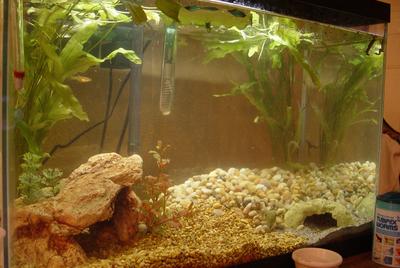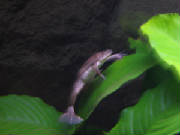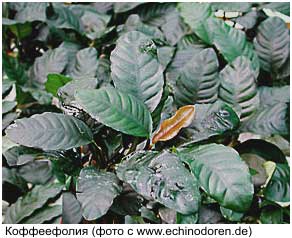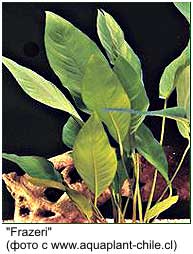|
A Natural Tank
Setting up a natural tank can be done using real or fake plants and all sizes of gravel and sand. The only *true* rules
to setting up a natural tank involves the only use of the colors brown and green (and all their shades and hues). The look
you are going for is a natural tank (sorry, no hot pink gravel and pearly plastic plants).
A basic set up would involve a natural colored gravel that is undyed. Natural gravel can be anywhere from a pale tan-almost
white to a dark brown-almost black. (Sand varies from pale to dark as well). If using plastic plants then make sure they are
only shades of green (unless you get a fake red ludwiga, then you may use one of these for some diffrent colors).
Decorations would involve natural rocks and wood (bogwood or driftwood). These can be arranged to make caves and hiding
spots for the frogs. They need places they can get under and behind to feel secure. If using rocks make sure they are a solid
and undyed color, usually in the grey to brown range. Also make sure all the surface areas of the rock are smooth to the touch.
Rough edges on rocks can scrach the frogs' skin and can tear the webbing on their feet. DO NOT use corals (real or fake) or
anything to that texture.
I strongly suggest using a backdrop for the back of the aquarium. Try and find something that matches the interior of
the tank. And remember, only green and brown still apply to the backdrop rules as well. Look for a natural backdrop with lots
of plants and wood in the picture. You may need to cover three sides of the tank for extra skittish frogs.
You can use real plants in a natural aquairum as well. But do keep in mind just about all the live plants you can buy
from a petstore will be destroyed by adult African Clawed Frogs. They have destructive natures towards plants and will tear
them up. African Dwarf Frogs will not bother any live plant at all, so all types can be used with them. When keeping African
Clawed Frogs I suggest using large and show sized Anubias species that will stand up to their aggressive nature in the
aquarium.
Also, two types of common house plants can live submerged underwater, Pothos and Philidendrum. These plants grow into
long vines and can be used to cover the back of an aquarium if draped down into the water. They will still grow submerged
but can also rot quickly. You must remove any part of the plant that appears to be dying.
Information and Pictures on setting up a Beautiful Natural Tank.
| A well done natural tank with live plants |

|
| notice the "greens and browns only" color scheme |
|
 |
 |
 |
A Biotope Tank
A Biotope tank mimics the natural habitat of the frog in the wild. Down to water quality, plant species and sometimes
even the rock and wood must come from that specific environment.
Water quality for African frogs (xenopus and hymenochirus) must be at a pH of 7.0-8.0 with a temperture of 70-75 F for
Xenopus and 70-75 F for Hymenochirus.
Plant species that are native to the frog's wild habitat are Anubias species. Anubias is an african bog plant that
is an easy grower and has no special lighting requirements. They are sometimes nicknamed the "plastic plant that grows". Anubias
can also stand up to the destructive nature of Xenopus. Anubias can be tied to driftwood and rocks and eventually the plant
will grow onto the object. Do not bury this plant into the gravel, attach it to a heavy object in the tank such as driftwood.
If you must bury this plant, do not bury the rhizome (the part of the plant that the leaves and roots grow out of), only bury
the roots.
Anubias species that I keep in my Xenopus tank
- 1 Anubias barteri "round leaf" - show size
- 2 Anubias barteri var. "barteri" - one large and one show size
- 1 Anubias barteri var. "barteri" marbled - small
- 1 Anubias barteri var. nana "wrinkled leaf" - show size
Anubias species that I keep in my Hymenochirus tank
- 1 Anubias barteri var. nana marbled - medium
- 2 Anubias barteri var. coffeeolia - both medium
Substrate should be a very fine gravel or sand of natural color. Some rocks are from Africa, such as African Rainbow Rock,
which also comes in gravel form. (I have this in both my tanks). Leaving the gravel flat across the tank is very unnatural.
Try banking it to one side, or creating little hills and mounds as well as making little dips in the gravel. This will
make the tank look a lot more natural. But the frogs will eventually kick everything flat again, so you can change up
the "landscape" every few weeks.
I suggest using driftwood and bogwood instead of larger rocks as decorations. It is more natural for the frogs and more
correct in the environment. Some types of bogwood are collected from African as well, try and use these. I use African driftwood
in both my tanks. If you plan on using some rocks as decorations try to find some that are large, round and smooth. Their
color should be solid from brown to grey.
For backdrops try and find those that are very rocky, or a view from a river bank with rocks and roots from trees. I use
these types of backdrops.
More Information on Biotope Environments
A Complete Listing of many diffrent types of Biotope environments
African Clawed Frogs in a Biotope
| My biotope tank |

|
| Sham peeking out of the anubias |
| "Tiwi" swiming through the anubias barteri |

|
| ACF biotope |
| Willow and Sham peeking out of the anubias |

|
| ACF biotope |
|
 |
 |
 |
|
Anubias Species
| Anubias barteri var. "NANA" (dwarf anubias) |

|
| Nana comes in many diffrent sizes, but this plant wont grow taller then 6-8 inches |
| Anubias barteri var. "BARTERI" |

|
| This plant will grow 16-18 inches in height |
| Anubias Coffefolia |

|
| possibly a hybrid anubias, it stays a. nana sized |
| Anubias Frazeri |

|
| another possible hybrid, this plant will get quite large as well. |
| Anubias Heterophylla |

|
| This plant is found all over west Africa |
| Huge tank full of Anubias barteri varieties! |

|
| Don't you want to toss a few frogs in here! :) |
Copyright TopTropicals 2004
The Most Imformative Site on Anubias That I Have Ever Found Online.
|
 |
|
|
|

